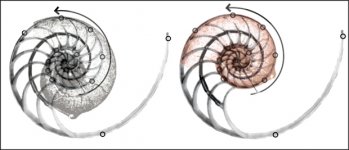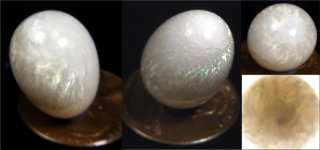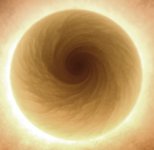Kieslinger's Perlenbildung (Pearl)
Kieslinger's Perlenbildung (Pearl)
Alois Kieslinger was one of the early 20th century's most prominent paleontologists and stratigraphers upon graduation from the University of Vienna in the early 1920s. He participated in the Second Netherlands Expedition to Timor in 1916 and based his post-graduate work on this, in the process naming several new species of Triassic Nautiloids.
Kieslinger later went on to utilize his groundbreaking research into rock weathering to apply himself to monument preservation, beginning with the Parthenon in Athens, and Vienna's own Ringstrasse.
On a tip buried deeply within a Swiss fossil collector's website, I researched Kieslinger's work for evidence of a mysterious Nautiloid fossil pearl?not a blister as seen in recent publicity posted by Pearly Shell on another thread. I was lucky enough to find the paper online after several days, including a detailed description and illustration of the specimen.
Below you will see Kieslinger's illustration (photo?), a modern Nautilus spiral section and my juxtaposition of the two as a means of reconstructing the missing body chamber of the fossil and to position the pearl (or blister pearl) anatomically.
Specimen is
Pleuronautilus pseudoplanilateratus KIESL. 1924. This is a true Nautiloid ancestor of the modern Nautilus, not an Ammonite, from the Triassic Period (200 MYA).
Remarkably, the loss of the last whorl and body chamber matrix has exposed the actual shell of the inner whorl, the pearl likely to be actual fossilized shell material.
In his text, Kieslinger states that he did not touch or section the pearl in any way (it belonged to the expedition financiers in any case), as it was so totally unique. Like Willey's Pearl (and Haynes' Pearl), we are in pursuit of this specimen?as it is likely to still exist?in order to subject it to modern non-invasive investigation techniques. It may be in Vienna, or the Netherlands.
Updating
Haynes' Pearl: Towards the end of his life, in 1924 (coincident to Kieslinger's work above!), Haynes presented an enlightened discourse on pearl formation to The Malacological Society, reported in T
he Journal of Molluscan Studies, the most prestigious scientific journal in its field to this day. Having held the pearl since its acquisition from the Sultanate of Sulu in 1884, the article lists it as having been sectioned (sacrificed) for 'photomicrography.' Unfortunately, the illustrative plates are not included in the downloaded pdf. Fortunately, we are in contact with a prominent member of the board of JMS, and fully anticipate receipt of the missing images soon.




